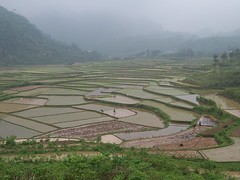A paddy field is a flooded parcel of arable land used for growing rice and other semiaquatic crops. Rice can also be grown in dry-fields, but from the twentieth century paddy field agriculture became the dominant form of growing rice.
The fields require large quantities of water for irrigation. Flooding provides water essential to the growth of the crop. Water also provides a favorable environment for the rice strains being grown as well as discouraging the growth of many species of weeds. The water buffalo is the only draft animal adapted for life in wetlands so they are extensively used in paddy fields.
Growing rice has an adverse environmental impact because of the large quantities of methane gas it generates.
This level of greenhouse gas generation is a large component of the global warming threat produced from an expanding human population. However, recent studies have shown that methane can be significantly reduced while also boosting crop yield by draining the paddies.[2]
The word "paddy" is derived from the Malay word padi, rice plant.[3]
Contents
Saturday, February 23, 2008
Subscribe to:
Post Comments (Atom)


No comments:
Post a Comment